lock BMW 528I SEDAN 2012 Owner's Manual
[x] Cancel search | Manufacturer: BMW, Model Year: 2012, Model line: 528I SEDAN, Model: BMW 528I SEDAN 2012Pages: 335, PDF Size: 13.16 MB
Page 59 of 335
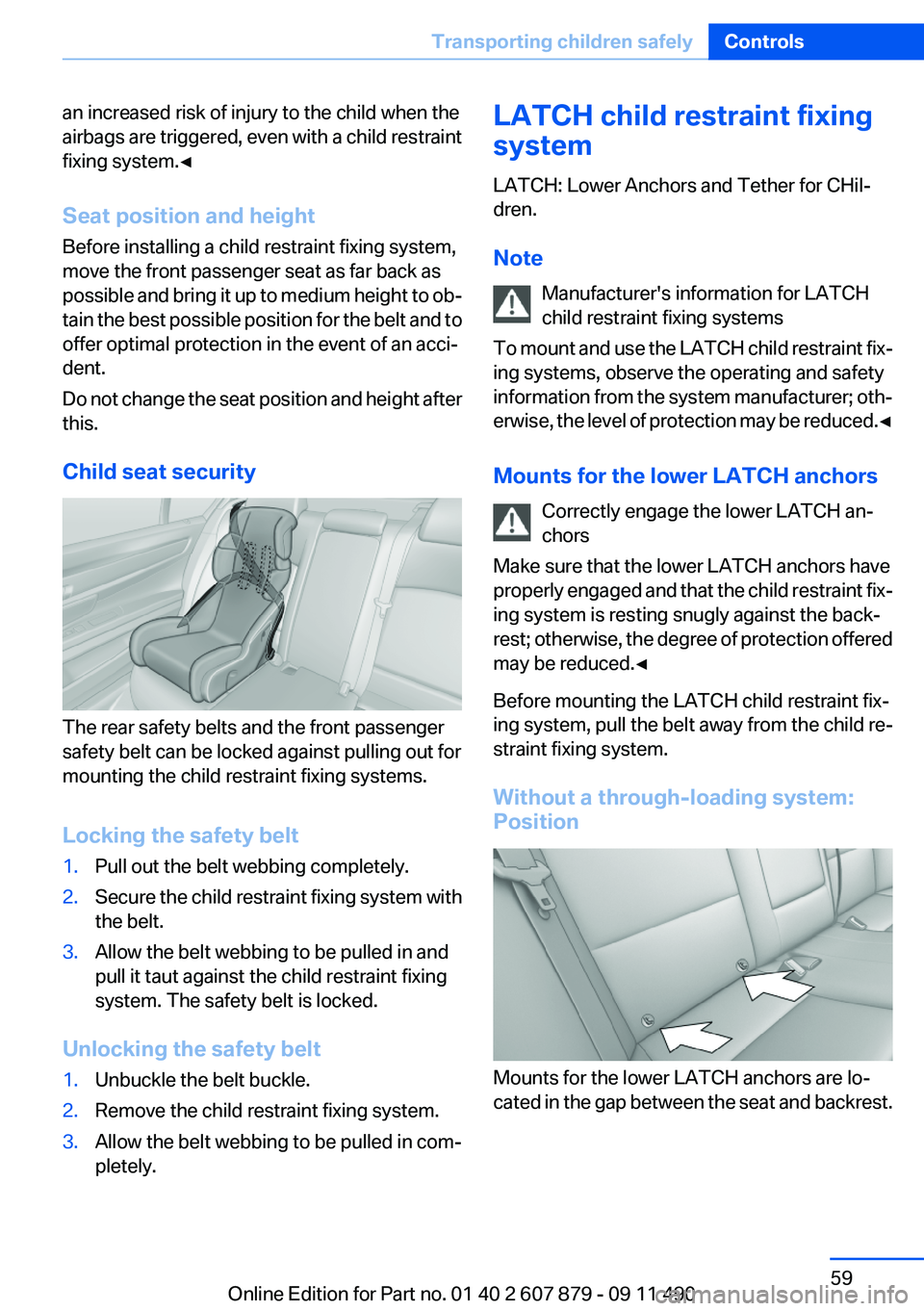
an increased risk of injury to the child when the
airbags are triggered, even with a child restraint
fixing system.‚óÄ
Seat position and height
Before installing a child restraint fixing system,
move the front passenger seat as far back as
possible and bring it up to medium height to ob‚Äź
tain the best possible position for the belt and to
offer optimal protection in the event of an acci‚Äź
dent.
Do not change the seat position and height after
this.
Child seat security
The rear safety belts and the front passenger
safety belt can be locked against pulling out for
mounting the child restraint fixing systems.
Locking the safety belt
1.Pull out the belt webbing completely.2.Secure the child restraint fixing system with
the belt.3.Allow the belt webbing to be pulled in and
pull it taut against the child restraint fixing
system. The safety belt is locked.
Unlocking the safety belt
1.Unbuckle the belt buckle.2.Remove the child restraint fixing system.3.Allow the belt webbing to be pulled in com‚Äź
pletely.LATCH child restraint fixing
system
LATCH: Lower Anchors and Tether for CHil‚Äź
dren.
Note Manufacturer's information for LATCH
child restraint fixing systems
To mount and use the LATCH child restraint fix‚Äź
ing systems, observe the operating and safety
information from the system manufacturer; oth‚Äź
erwise, the level of protection may be reduced. ‚óÄ
Mounts for the lower LATCH anchors Correctly engage the lower LATCH an‚Äź
chors
Make sure that the lower LATCH anchors have
properly engaged and that the child restraint fix‚Äź
ing system is resting snugly against the back‚Äź
rest; otherwise, the degree of protection offered
may be reduced.‚óÄ
Before mounting the LATCH child restraint fix‚Äź
ing system, pull the belt away from the child re‚Äź
straint fixing system.
Without a through-loading system:
Position
Mounts for the lower LATCH anchors are lo‚Äź
cated in the gap between the seat and backrest.
Seite 59Transporting children safelyControls59
Online Edition for Part no. 01 40 2 607 879 - 09 11 490
Page 61 of 335
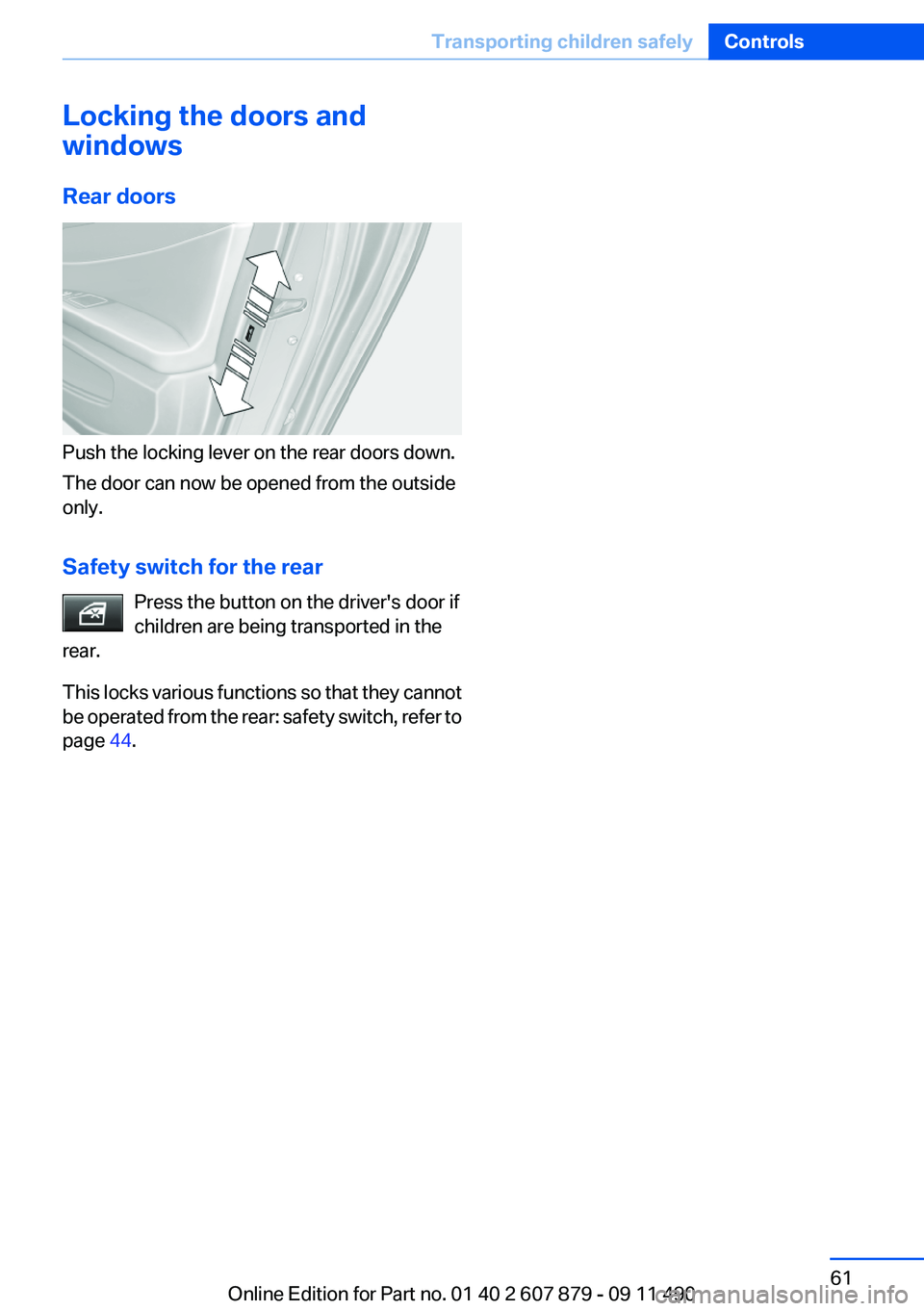
Locking the doors and
windows
Rear doors
Push the locking lever on the rear doors down.
The door can now be opened from the outside
only.
Safety switch for the rear Press the button on the driver's door if
children are being transported in the
rear.
This locks various functions so that they cannot
be operated from the rear: safety switch, refer to
page 44.
Seite 61Transporting children safelyControls61
Online Edition for Part no. 01 40 2 607 879 - 09 11 490
Page 62 of 335
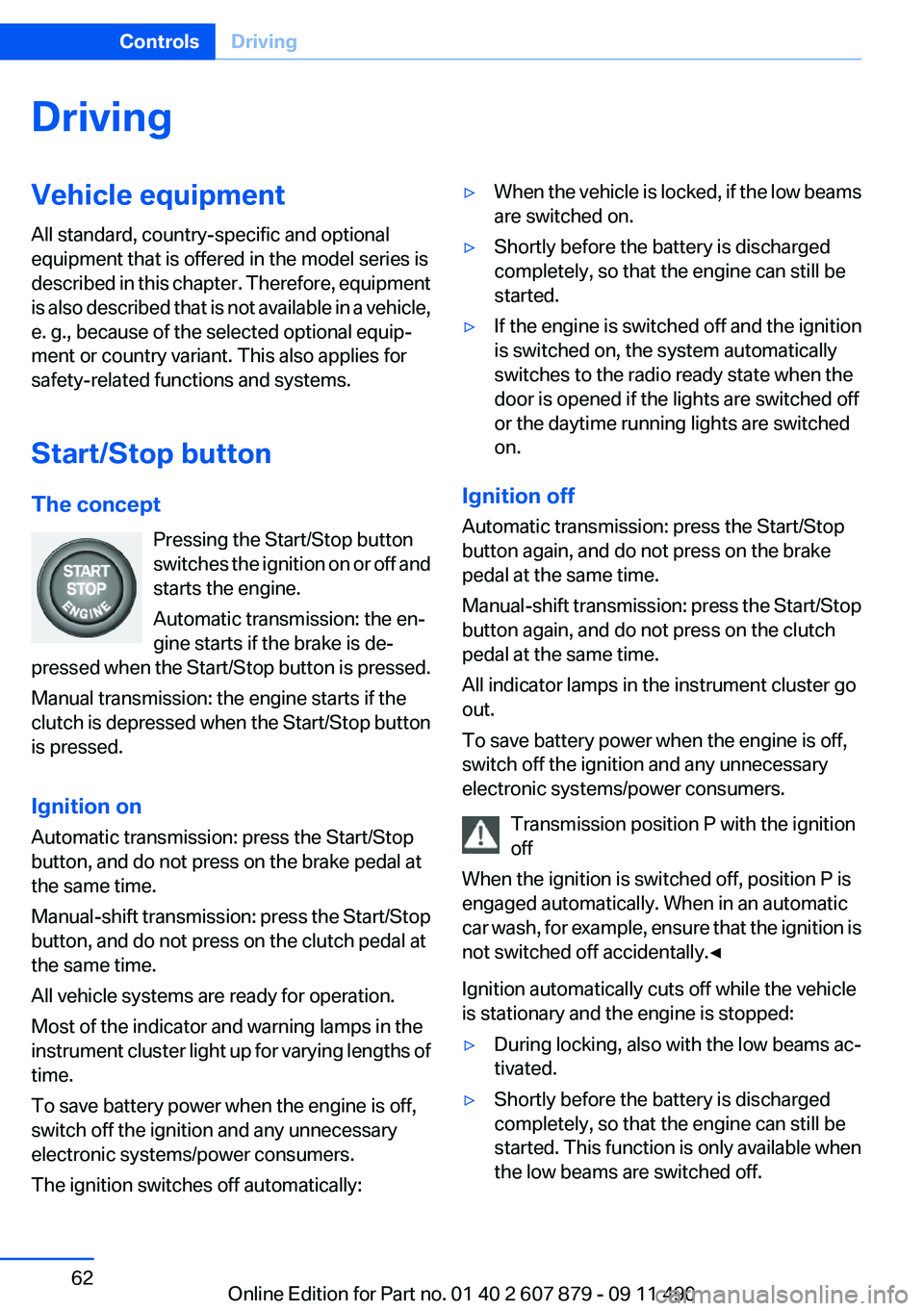
DrivingVehicle equipment
All standard, country-specific and optional
equipment that is offered in the model series is
described in this chapter. Therefore, equipment
is also described that is not available in a vehicle,
e. g., because of the selected optional equip‚Äź
ment or country variant. This also applies for
safety-related functions and systems.
Start/Stop button
The concept Pressing the Start/Stop button
switches the ignition on or off and
starts the engine.
Automatic transmission: the en‚Äź
gine starts if the brake is de‚Äź
pressed when the Start/Stop button is pressed.
Manual transmission: the engine starts if the
clutch is depressed when the Start/Stop button
is pressed.
Ignition on
Automatic transmission: press the Start/Stop
button, and do not press on the brake pedal at
the same time.
Manual-shift transmission: press the Start/Stop
button, and do not press on the clutch pedal at
the same time.
All vehicle systems are ready for operation.
Most of the indicator and warning lamps in the
instrument cluster light up for varying lengths of
time.
To save battery power when the engine is off,
switch off the ignition and any unnecessary
electronic systems/power consumers.
The ignition switches off automatically:‚Ė∑When the vehicle is locked, if the low beams
are switched on.‚Ė∑Shortly before the battery is discharged
completely, so that the engine can still be
started.‚Ė∑If the engine is switched off and the ignition
is switched on, the system automatically
switches to the radio ready state when the
door is opened if the lights are switched off
or the daytime running lights are switched
on.
Ignition off
Automatic transmission: press the Start/Stop
button again, and do not press on the brake
pedal at the same time.
Manual-shift transmission: press the Start/Stop
button again, and do not press on the clutch
pedal at the same time.
All indicator lamps in the instrument cluster go
out.
To save battery power when the engine is off,
switch off the ignition and any unnecessary
electronic systems/power consumers.
Transmission position P with the ignition
off
When the ignition is switched off, position P is
engaged automatically. When in an automatic
car wash, for example, ensure that the ignition is
not switched off accidentally.‚óÄ
Ignition automatically cuts off while the vehicle
is stationary and the engine is stopped:
‚Ė∑During locking, also with the low beams ac‚Äź
tivated.‚Ė∑Shortly before the battery is discharged
completely, so that the engine can still be
started. This function is only available when
the low beams are switched off.Seite 62ControlsDriving62
Online Edition for Part no. 01 40 2 607 879 - 09 11 490
Page 63 of 335
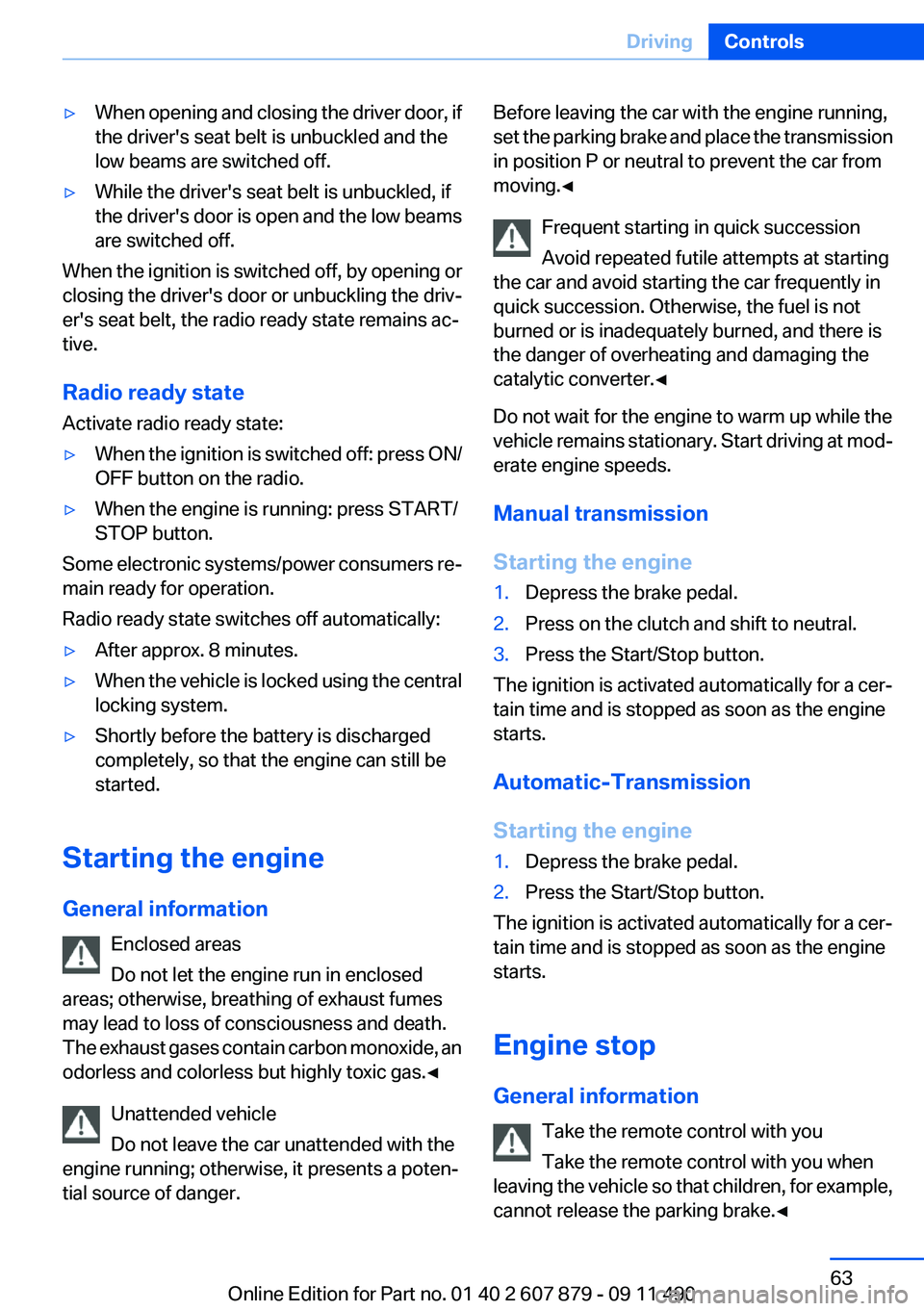
‚Ė∑When opening and closing the driver door, if
the driver's seat belt is unbuckled and the
low beams are switched off.‚Ė∑While the driver's seat belt is unbuckled, if
the driver's door is open and the low beams
are switched off.
When the ignition is switched off, by opening or
closing the driver's door or unbuckling the driv‚Äź
er's seat belt, the radio ready state remains ac‚Äź
tive.
Radio ready state
Activate radio ready state:
‚Ė∑When the ignition is switched off: press ON/
OFF button on the radio.‚Ė∑When the engine is running: press START/
STOP button.
Some electronic systems/power consumers re‚Äź
main ready for operation.
Radio ready state switches off automatically:
‚Ė∑After approx. 8 minutes.‚Ė∑When the vehicle is locked using the central
locking system.‚Ė∑Shortly before the battery is discharged
completely, so that the engine can still be
started.
Starting the engine
General information Enclosed areas
Do not let the engine run in enclosed
areas; otherwise, breathing of exhaust fumes
may lead to loss of consciousness and death.
The exhaust gases contain carbon monoxide, an
odorless and colorless but highly toxic gas.‚óÄ
Unattended vehicle
Do not leave the car unattended with the
engine running; otherwise, it presents a poten‚Äź
tial source of danger.
Before leaving the car with the engine running,
set the parking brake and place the transmission
in position P or neutral to prevent the car from
moving.‚óÄ
Frequent starting in quick succession
Avoid repeated futile attempts at starting
the car and avoid starting the car frequently in
quick succession. Otherwise, the fuel is not
burned or is inadequately burned, and there is
the danger of overheating and damaging the
catalytic converter.‚óÄ
Do not wait for the engine to warm up while the
vehicle remains stationary. Start driving at mod‚Äź
erate engine speeds.
Manual transmission
Starting the engine1.Depress the brake pedal.2.Press on the clutch and shift to neutral.3.Press the Start/Stop button.
The ignition is activated automatically for a cer‚Äź
tain time and is stopped as soon as the engine
starts.
Automatic-Transmission
Starting the engine
1.Depress the brake pedal.2.Press the Start/Stop button.
The ignition is activated automatically for a cer‚Äź
tain time and is stopped as soon as the engine
starts.
Engine stop
General information Take the remote control with you
Take the remote control with you when
leaving the vehicle so that children, for example,
cannot release the parking brake.‚óÄ
Seite 63DrivingControls63
Online Edition for Part no. 01 40 2 607 879 - 09 11 490
Page 65 of 335
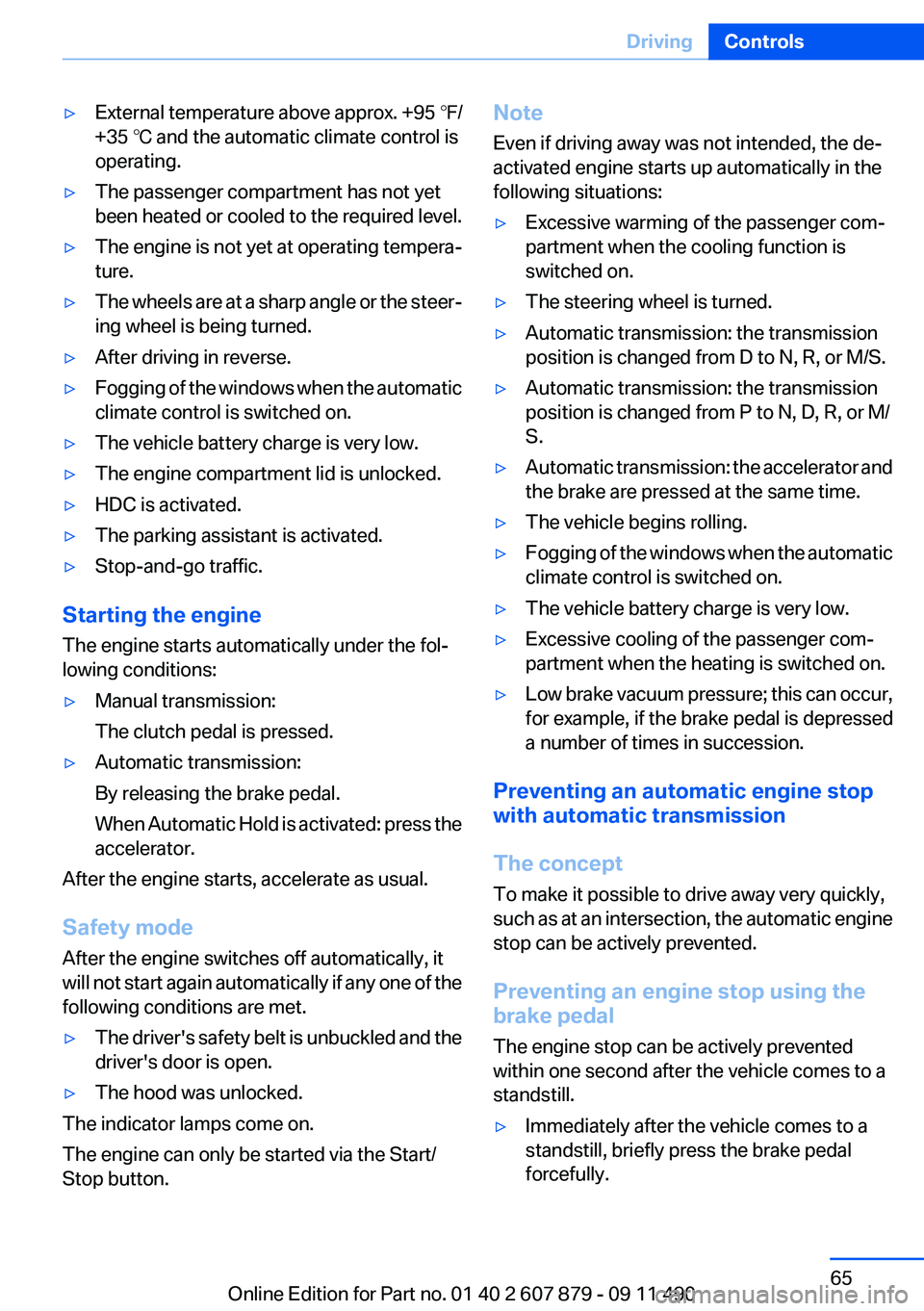
‚Ė∑External temperature above approx. +95 ‚ĄČ/
+35 ‚ĄÉ and the automatic climate control is
operating.‚Ė∑The passenger compartment has not yet
been heated or cooled to the required level.‚Ė∑The engine is not yet at operating tempera‚Äź
ture.‚Ė∑The wheels are at a sharp angle or the steer‚Äź
ing wheel is being turned.‚Ė∑After driving in reverse.‚Ė∑Fogging of the windows when the automatic
climate control is switched on.‚Ė∑The vehicle battery charge is very low.‚Ė∑The engine compartment lid is unlocked.‚Ė∑HDC is activated.‚Ė∑The parking assistant is activated.‚Ė∑Stop-and-go traffic.
Starting the engine
The engine starts automatically under the fol‚Äź
lowing conditions:
‚Ė∑Manual transmission:
The clutch pedal is pressed.‚Ė∑Automatic transmission:
By releasing the brake pedal.
When Automatic Hold is activated: press the
accelerator.
After the engine starts, accelerate as usual.
Safety mode
After the engine switches off automatically, it
will not start again automatically if any one of the
following conditions are met.
‚Ė∑The driver's safety belt is unbuckled and the
driver's door is open.‚Ė∑The hood was unlocked.
The indicator lamps come on.
The engine can only be started via the Start/
Stop button.
Note
Even if driving away was not intended, the de‚Äź
activated engine starts up automatically in the
following situations:‚Ė∑Excessive warming of the passenger com‚Äź
partment when the cooling function is
switched on.‚Ė∑The steering wheel is turned.‚Ė∑Automatic transmission: the transmission
position is changed from D to N, R, or M/S.‚Ė∑Automatic transmission: the transmission
position is changed from P to N, D, R, or M/
S.‚Ė∑Automatic transmission: the accelerator and
the brake are pressed at the same time.‚Ė∑The vehicle begins rolling.‚Ė∑Fogging of the windows when the automatic
climate control is switched on.‚Ė∑The vehicle battery charge is very low.‚Ė∑Excessive cooling of the passenger com‚Äź
partment when the heating is switched on.‚Ė∑Low brake vacuum pressure; this can occur,
for example, if the brake pedal is depressed
a number of times in succession.
Preventing an automatic engine stop
with automatic transmission
The concept
To make it possible to drive away very quickly,
such as at an intersection, the automatic engine
stop can be actively prevented.
Preventing an engine stop using the
brake pedal
The engine stop can be actively prevented
within one second after the vehicle comes to a
standstill.
‚Ė∑Immediately after the vehicle comes to a
standstill, briefly press the brake pedal
forcefully.Seite 65DrivingControls65
Online Edition for Part no. 01 40 2 607 879 - 09 11 490
Page 72 of 335
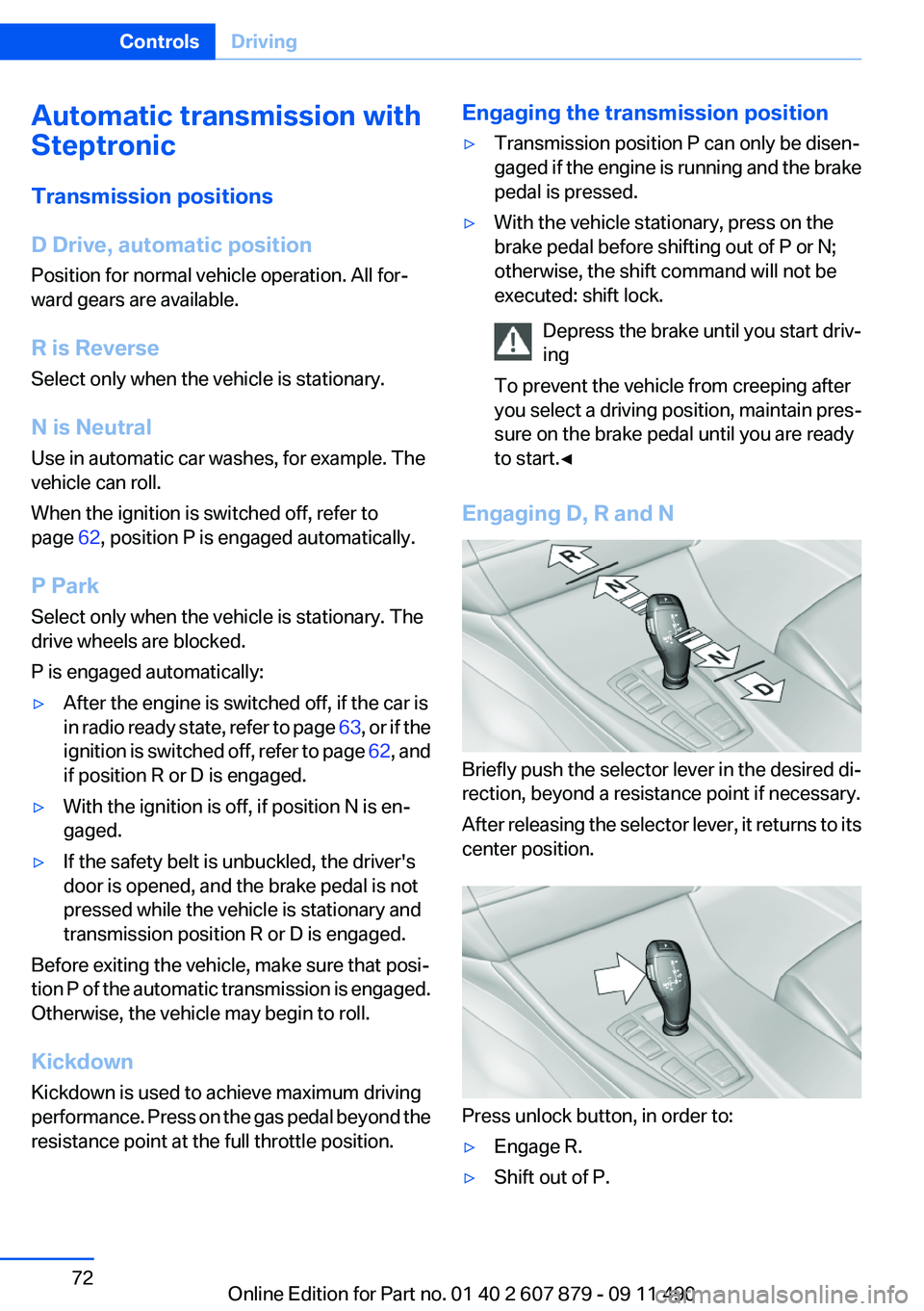
Automatic transmission with
Steptronic
Transmission positions
D Drive, automatic position
Position for normal vehicle operation. All for‚Äź
ward gears are available.
R is Reverse
Select only when the vehicle is stationary.
N is Neutral
Use in automatic car washes, for example. The
vehicle can roll.
When the ignition is switched off, refer to
page 62, position P is engaged automatically.
P Park
Select only when the vehicle is stationary. The
drive wheels are blocked.
P is engaged automatically:‚Ė∑After the engine is switched off, if the car is
in radio ready state, refer to page 63, or if the
ignition is switched off, refer to page 62, and
if position R or D is engaged.‚Ė∑With the ignition is off, if position N is en‚Äź
gaged.‚Ė∑If the safety belt is unbuckled, the driver's
door is opened, and the brake pedal is not
pressed while the vehicle is stationary and
transmission position R or D is engaged.
Before exiting the vehicle, make sure that posi‚Äź
tion P of the automatic transmission is engaged.
Otherwise, the vehicle may begin to roll.
Kickdown
Kickdown is used to achieve maximum driving
performance. Press on the gas pedal beyond the
resistance point at the full throttle position.
Engaging the transmission position‚Ė∑Transmission position P can only be disen‚Äź
gaged if the engine is running and the brake
pedal is pressed.‚Ė∑With the vehicle stationary, press on the
brake pedal before shifting out of P or N;
otherwise, the shift command will not be
executed: shift lock.
Depress the brake until you start driv‚Äź
ing
To prevent the vehicle from creeping after
you select a driving position, maintain pres‚Äź
sure on the brake pedal until you are ready
to start.‚óÄ
Engaging D, R and N
Briefly push the selector lever in the desired di‚Äź
rection, beyond a resistance point if necessary.
After releasing the selector lever, it returns to its
center position.
Press unlock button, in order to:
‚Ė∑Engage R.‚Ė∑Shift out of P.Seite 72ControlsDriving72
Online Edition for Part no. 01 40 2 607 879 - 09 11 490
Page 79 of 335
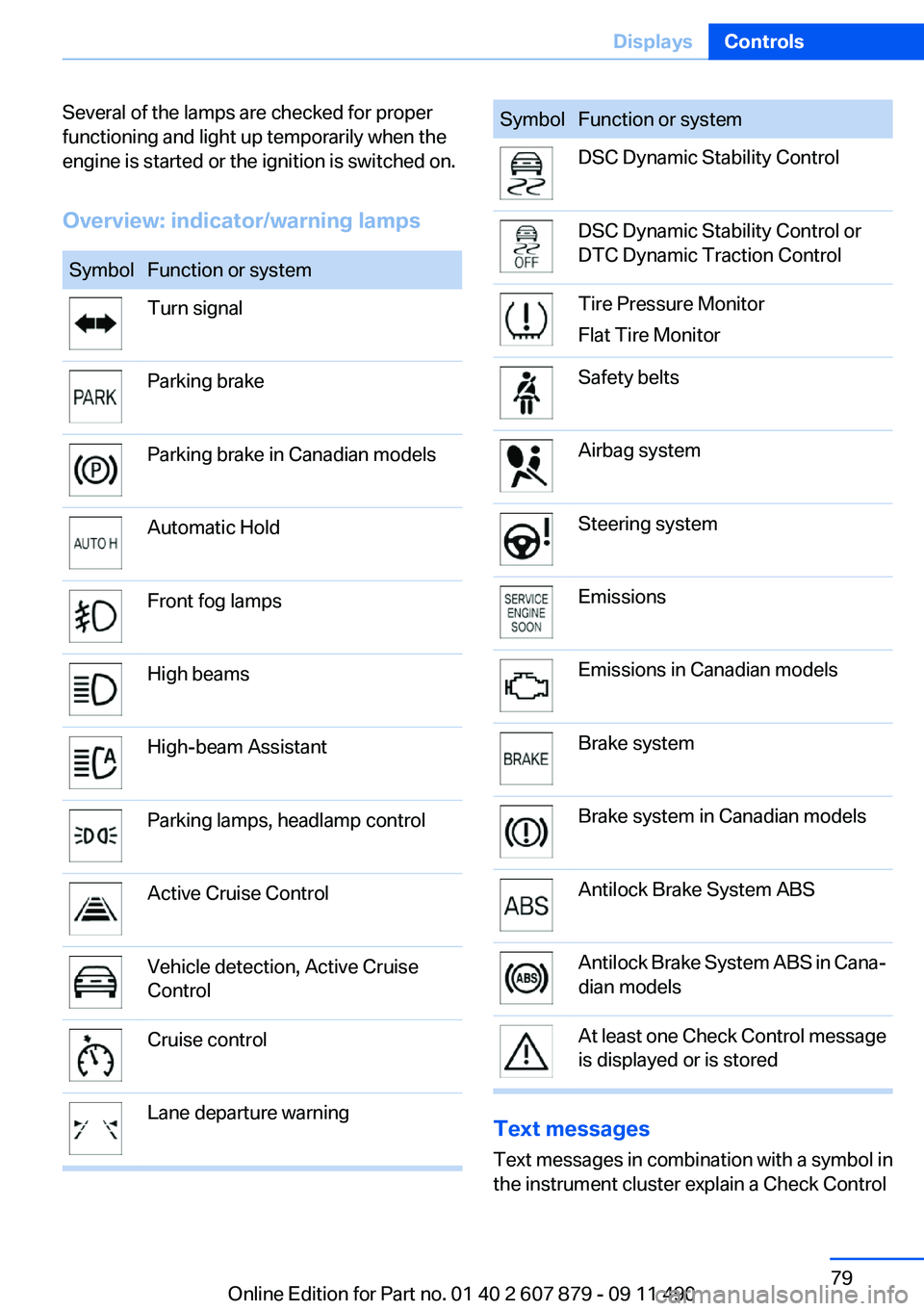
Several of the lamps are checked for proper
functioning and light up temporarily when the
engine is started or the ignition is switched on.
Overview: indicator/warning lampsSymbolFunction or systemTurn signalParking brakeParking brake in Canadian modelsAutomatic HoldFront fog lampsHigh beamsHigh-beam AssistantParking lamps, headlamp controlActive Cruise ControlVehicle detection, Active Cruise
ControlCruise controlLane departure warningSymbolFunction or systemDSC Dynamic Stability ControlDSC Dynamic Stability Control or
DTC Dynamic Traction ControlTire Pressure Monitor
Flat Tire MonitorSafety beltsAirbag systemSteering systemEmissionsEmissions in Canadian modelsBrake systemBrake system in Canadian modelsAntilock Brake System ABSAntilock Brake System ABS in Cana‚Äź
dian modelsAt least one Check Control message
is displayed or is stored
Text messages
Text messages in combination with a symbol in
the instrument cluster explain a Check Control
Seite 79DisplaysControls79
Online Edition for Part no. 01 40 2 607 879 - 09 11 490
Page 89 of 335
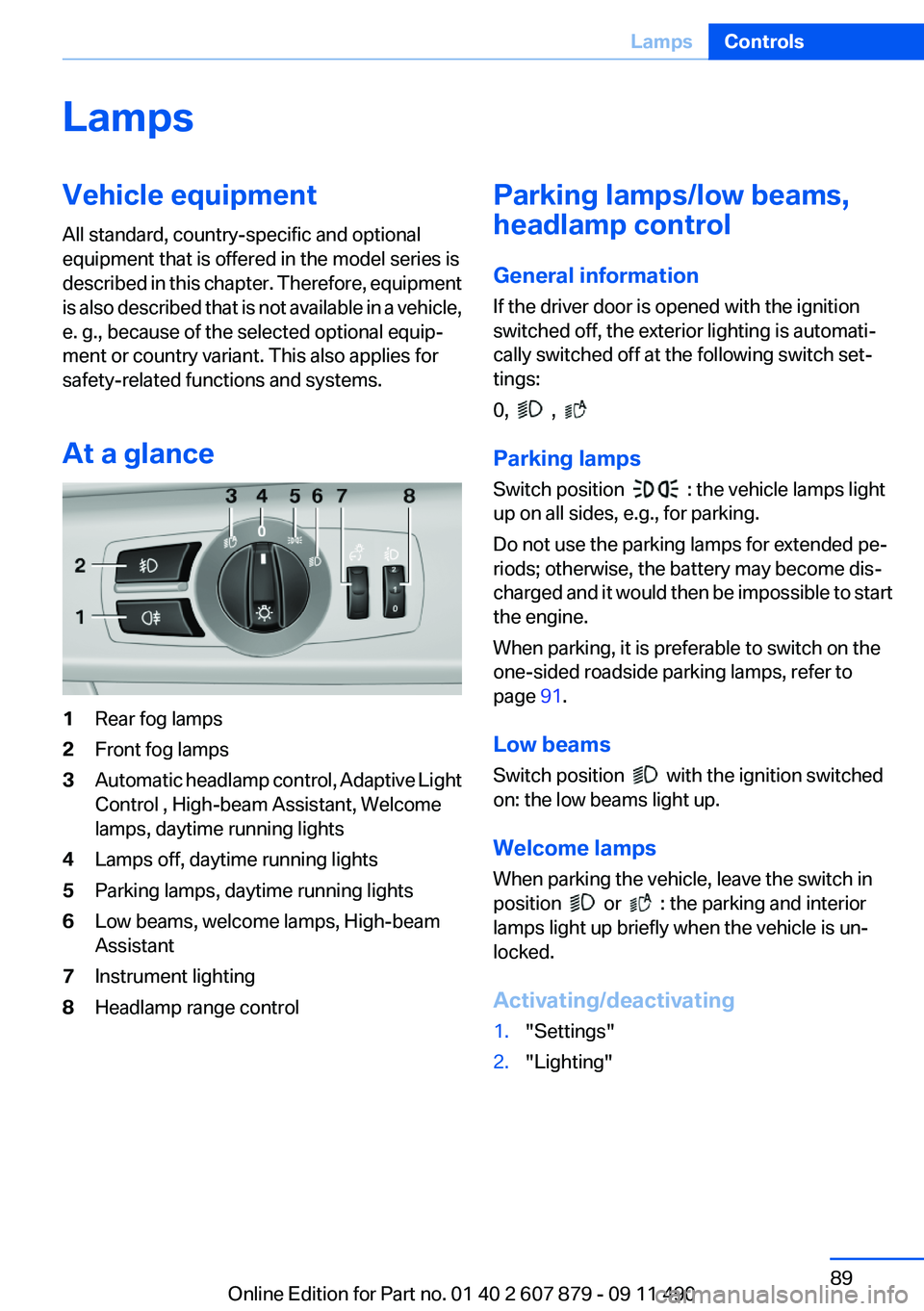
LampsVehicle equipment
All standard, country-specific and optional
equipment that is offered in the model series is
described in this chapter. Therefore, equipment
is also described that is not available in a vehicle,
e. g., because of the selected optional equip‚Äź
ment or country variant. This also applies for
safety-related functions and systems.
At a glance1Rear fog lamps2Front fog lamps3Automatic headlamp control, Adaptive Light
Control , High-beam Assistant, Welcome
lamps, daytime running lights4Lamps off, daytime running lights5Parking lamps, daytime running lights6Low beams, welcome lamps, High-beam
Assistant7Instrument lighting8Headlamp range controlParking lamps/low beams,
headlamp control
General information
If the driver door is opened with the ignition
switched off, the exterior lighting is automati‚Äź
cally switched off at the following switch set‚Äź
tings:
0,
,
Parking lamps
Switch position
: the vehicle lamps light
up on all sides, e.g., for parking.
Do not use the parking lamps for extended pe‚Äź
riods; otherwise, the battery may become dis‚Äź
charged and it would then be impossible to start
the engine.
When parking, it is preferable to switch on the
one-sided roadside parking lamps, refer to
page 91.
Low beams
Switch position
with the ignition switched
on: the low beams light up.
Welcome lamps
When parking the vehicle, leave the switch in
position
or : the parking and interior
lamps light up briefly when the vehicle is un‚Äź
locked.
Activating/deactivating
1."Settings"2."Lighting"Seite 89LampsControls89
Online Edition for Part no. 01 40 2 607 879 - 09 11 490
Page 95 of 335
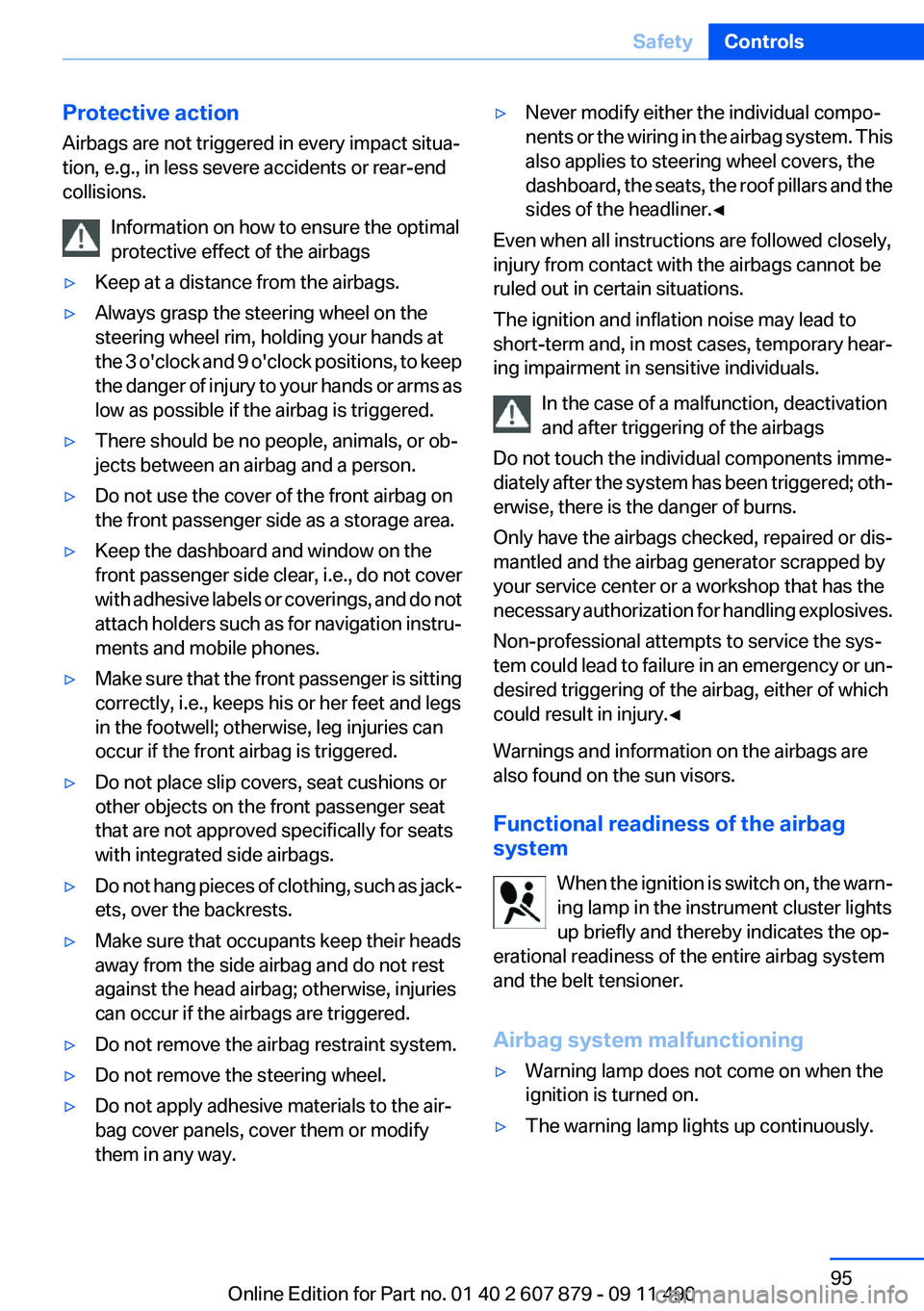
Protective action
Airbags are not triggered in every impact situa‚Äź
tion, e.g., in less severe accidents or rear-end
collisions.
Information on how to ensure the optimal
protective effect of the airbags‚Ė∑Keep at a distance from the airbags.‚Ė∑Always grasp the steering wheel on the
steering wheel rim, holding your hands at
the 3 o'clock and 9 o'clock positions, to keep
the danger of injury to your hands or arms as
low as possible if the airbag is triggered.‚Ė∑There should be no people, animals, or ob‚Äź
jects between an airbag and a person.‚Ė∑Do not use the cover of the front airbag on
the front passenger side as a storage area.‚Ė∑Keep the dashboard and window on the
front passenger side clear, i.e., do not cover
with adhesive labels or coverings, and do not
attach holders such as for navigation instru‚Äź
ments and mobile phones.‚Ė∑Make sure that the front passenger is sitting
correctly, i.e., keeps his or her feet and legs
in the footwell; otherwise, leg injuries can
occur if the front airbag is triggered.‚Ė∑Do not place slip covers, seat cushions or
other objects on the front passenger seat
that are not approved specifically for seats
with integrated side airbags.‚Ė∑Do not hang pieces of clothing, such as jack‚Äź
ets, over the backrests.‚Ė∑Make sure that occupants keep their heads
away from the side airbag and do not rest
against the head airbag; otherwise, injuries
can occur if the airbags are triggered.‚Ė∑Do not remove the airbag restraint system.‚Ė∑Do not remove the steering wheel.‚Ė∑Do not apply adhesive materials to the air‚Äź
bag cover panels, cover them or modify
them in any way.‚Ė∑Never modify either the individual compo‚Äź
nents or the wiring in the airbag system. This
also applies to steering wheel covers, the
dashboard, the seats, the roof pillars and the
sides of the headliner.‚óÄ
Even when all instructions are followed closely,
injury from contact with the airbags cannot be
ruled out in certain situations.
The ignition and inflation noise may lead to
short-term and, in most cases, temporary hear‚Äź
ing impairment in sensitive individuals.
In the case of a malfunction, deactivation
and after triggering of the airbags
Do not touch the individual components imme‚Äź
diately after the system has been triggered; oth‚Äź
erwise, there is the danger of burns.
Only have the airbags checked, repaired or dis‚Äź
mantled and the airbag generator scrapped by
your service center or a workshop that has the
necessary authorization for handling explosives.
Non-professional attempts to service the sys‚Äź
tem could lead to failure in an emergency or un‚Äź
desired triggering of the airbag, either of which
could result in injury.‚óÄ
Warnings and information on the airbags are
also found on the sun visors.
Functional readiness of the airbag
system
When the ignition is switch on, the warn‚Äź
ing lamp in the instrument cluster lights
up briefly and thereby indicates the op‚Äź
erational readiness of the entire airbag system
and the belt tensioner.
Airbag system malfunctioning
‚Ė∑Warning lamp does not come on when the
ignition is turned on.‚Ė∑The warning lamp lights up continuously.Seite 95SafetyControls95
Online Edition for Part no. 01 40 2 607 879 - 09 11 490
Page 107 of 335
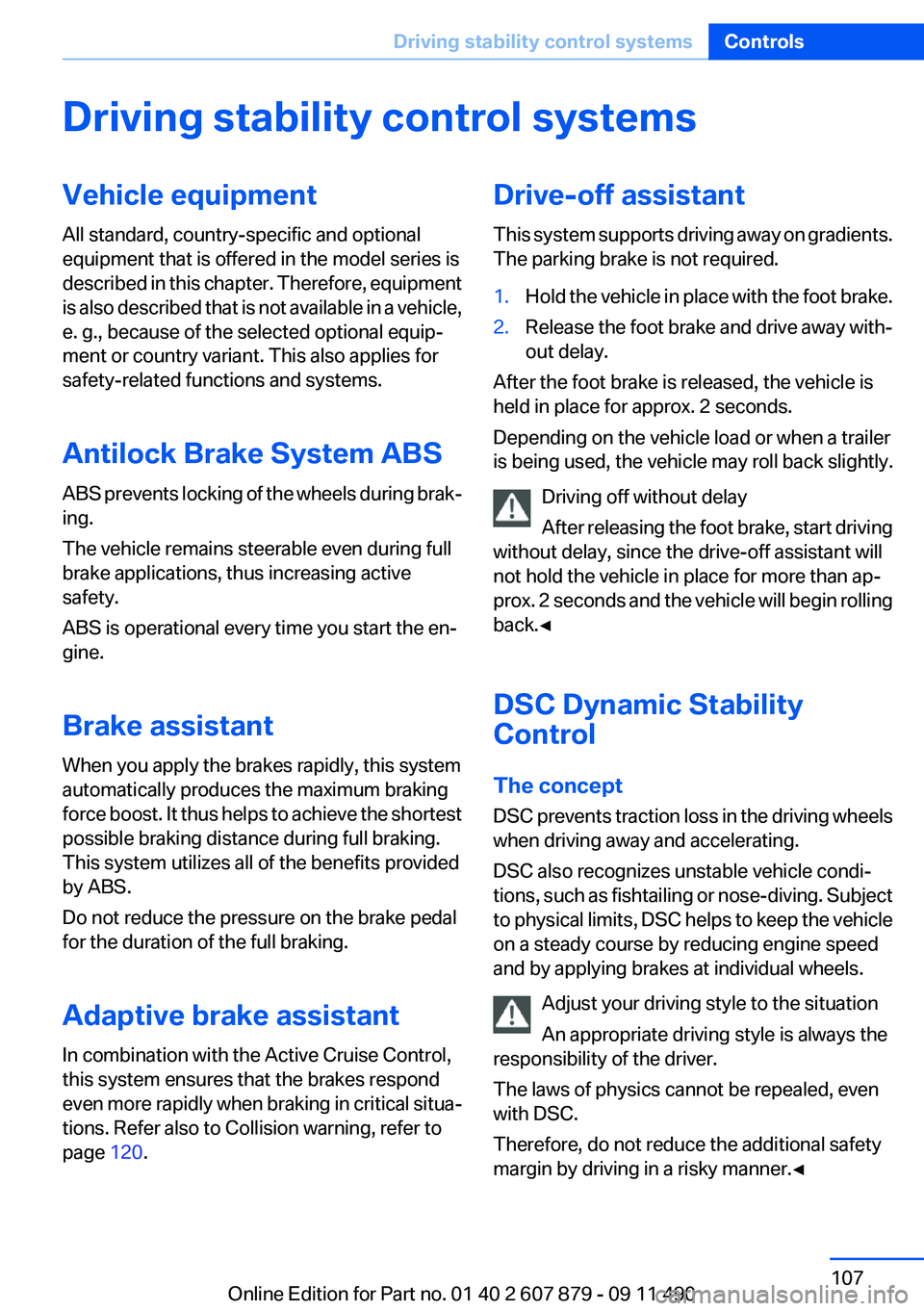
Driving stability control systemsVehicle equipment
All standard, country-specific and optional
equipment that is offered in the model series is
described in this chapter. Therefore, equipment
is also described that is not available in a vehicle,
e. g., because of the selected optional equip‚Äź
ment or country variant. This also applies for
safety-related functions and systems.
Antilock Brake System ABS
ABS prevents locking of the wheels during brak‚Äź
ing.
The vehicle remains steerable even during full
brake applications, thus increasing active
safety.
ABS is operational every time you start the en‚Äź
gine.
Brake assistant
When you apply the brakes rapidly, this system
automatically produces the maximum braking
force boost. It thus helps to achieve the shortest
possible braking distance during full braking.
This system utilizes all of the benefits provided
by ABS.
Do not reduce the pressure on the brake pedal
for the duration of the full braking.
Adaptive brake assistant
In combination with the Active Cruise Control,
this system ensures that the brakes respond
even more rapidly when braking in critical situa‚Äź
tions. Refer also to Collision warning, refer to
page 120.Drive-off assistant
This system supports driving away on gradients.
The parking brake is not required.1.Hold the vehicle in place with the foot brake.2.Release the foot brake and drive away with‚Äź
out delay.
After the foot brake is released, the vehicle is
held in place for approx. 2 seconds.
Depending on the vehicle load or when a trailer
is being used, the vehicle may roll back slightly.
Driving off without delay
After releasing the foot brake, start driving
without delay, since the drive-off assistant will
not hold the vehicle in place for more than ap‚Äź
prox. 2 seconds and the vehicle will begin rolling
back.‚óÄ
DSC Dynamic Stability
Control
The concept
DSC prevents traction loss in the driving wheels
when driving away and accelerating.
DSC also recognizes unstable vehicle condi‚Äź
tions, such as fishtailing or nose-diving. Subject
to physical limits, DSC helps to keep the vehicle
on a steady course by reducing engine speed
and by applying brakes at individual wheels.
Adjust your driving style to the situation
An appropriate driving style is always the
responsibility of the driver.
The laws of physics cannot be repealed, even
with DSC.
Therefore, do not reduce the additional safety
margin by driving in a risky manner.‚óÄ
Seite 107Driving stability control systemsControls107
Online Edition for Part no. 01 40 2 607 879 - 09 11 490